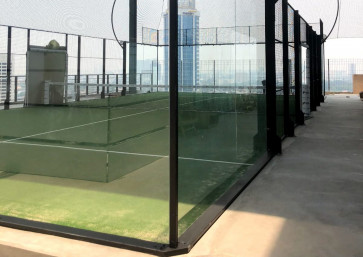Popular Reads
Top Results
Can't find what you're looking for?
View all search resultsPopular Reads
Top Results
Can't find what you're looking for?
View all search resultsYola Yulfianti: Making a stage for urban issues
Choreographer Yola Yulfianti (left) poses with Japanese light designer Ryoya Fudetani (JP/Tertiani ZB Simanjuntak)As a choreographer, Yola Yulfianti had long felt the alienation of her profession from the society that inspired her works
Change text size
Gift Premium Articles
to Anyone
Choreographer Yola Yulfianti (left) poses with Japanese light designer Ryoya Fudetani (JP/Tertiani ZB Simanjuntak)
As a choreographer, Yola Yulfianti had long felt the alienation of her profession from the society that inspired her works.
Born on July 21 in the alleys of Pasar Genjing, Pramuka, East Jakarta, Yola is literally dancing for her life.
She was often too ill to go to school and at one time had to stay home for three months due to bronchitis. When her parents asked the ailing Yola what she wanted to do, she chose dance.
She started learning traditional dances when she was a third-grader in elementary school.
'Miraculously, I got healthier and always came first in class. Perhaps, dancing made my blood circulation better and somehow I just became smarter,' said the mother of a 7-year-old.
She followed in the steps of her dance tutor, Wiwik HW, by entering the Jakarta Institute of Arts (IKJ) and was granted a scholarship by the noted dance choreographer, the late Deddy Luthan.
She graduated as a dance major in 2004 and has since worked hard to get public recognition.
With a postgraduate degree in urban art and the culture industry from the IKJ, Yola has produced a number of choreographies and dance films and collaborated with choreographers and directors from abroad. In 2010, she cofounded Indonesian Dance Expression, which develops mixed-media performances.
The offer to join a project for Jakarta Art Movement in the Penjaringan slum in North Jakarta back in 2012 turned out to be an eye-opener for Yola as she explored the issue of clean water scarcity.
Her work, titled Payau #2 Waterproof, was the main performance for the 11th Indonesian Dance Festival that year and marked her effort to connect with social problems.
It was a point of no return for her.
'In my previous exploration inside a community, the focus was only on the body language that inspired my dance movement, but was not necessarily connected to the community members.
'When I started the research in Penjaringan, the interaction with the people and their problems and the process to find the answers to those problems struck me. It was addictive,' she said.
Another offer came to teach dance for free to the young people in kampung Johar, a slum in Central Jakarta notorious for brawls and drug abuse.
She took the challenge but soon left for a two-month fellowship with FACETS, a choreographer residency in India where she and another 15 international dance choreographers were mentored by experts in choreography, theater, digital arts and light and sound design.
During the residency, she choreographed Salma ' A Little Escape, which told the story of women in the slums of India who have limited rights and freedom.
Her work was premiered at the Attakkalari India Biennial, South Asia's largest international contemporary movement and mixed-arts festival at the end of the fellowship in early 2013.
'Without realizing it, I started to explore choreographing in tight spaces. I put a box on stage to represent the small houses in the slums,' she said.
She returned to Johar to give more dance lessons until the project ended. But, to her surprise, the young kampung people looked for her and asked her to continue the lessons.
'I came as a friend and listened to their stories. From there I got the inspiration to make a dance concept, but at that time I didn't know how to put it on stage.'
The application opening for Hibah Cipta Perempuan in early 2014, a grant for women artists provided by Yayasan Kelola ' a foundation focusing on the development of national arts and cultures ' came at the right time.
Yola won the grant and she invited Japanese light designer Ryoya Fudetani to work with her on I Think '¦ Tonk that had been performed on Sept. 16 at Graha Bentara Budaya Taman Ismail Marzuki art center in Cikini, Central Jakarta.
'The title means nothing as it came from one of the kampung people who tried to speak in English but could not finish the sentence. Coincidentally, Otong is the name of a resident who intended to see some changes in his neighborhood and got me into the project at the start,' said Yola.
'But it well described the story of the kampung people who dreamed big but didn't think much of their future. They live right in the heart of a big city, but have no knowledge of what's happening out there.'
The research for the stage setting itself was as memorable as the performance for both Yola and Fudetani.
'I took the dancers to Johar and we practiced in the alleys and outside the kampung homes,' said Yola.
Yola used mixed media for the performance, adding moving pictures of the kampung people ' some were taken by Otong ' as the stage background.
As a foreigner, Fudetani caught the essence of Johar, the notorious poster boy of Jakarta slums. After a week of living with the kampung people, he took the bold decision to use light sources other than the normal artistic stage lighting.
He used Christmas chasing lights stretching above to define a height limit for the stage ' to depict the densely populated, jam-packed Johar ' and to mimic odong-odong, the overly accessorized and noisy fun ride for the kampung children.
Fudetani also brought stray cats onto the stage and the rows of doors with different colors and types, of which he said 'so Jakarta'.
'What's good about the performance was that although it's about the kampung, it actually had a universal issue of the quest for happiness,' he said.
Yola said she would expand her latest work into an exhibition right in Johar, where the children she had taught dancing could also perform.
'I want to bring people to their world, to their imaginary world. It's going to be an endless task for me,' she said.
'The research method I just learned from my experiences in Johar is applicable anywhere. It's not something you learn from a book, it's how you process as an artist.'










